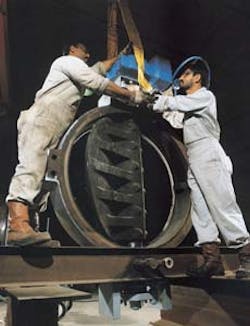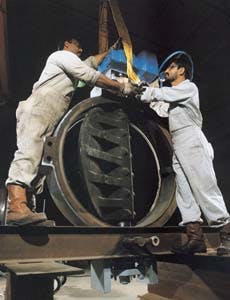MIDDLE EAST Saudi Aramco's mammoth Safaniya, NAPR recompletion project concluded
$35 billion revitalization centered on world's largest offshore field,
included expansions of Marjan and Zuluf
(Photo courtesy of Saudi Aramco)
It has taken something more than the initially projected three-years, but Saudi Aramco has successfully concluded one of the offshore petroleum industry's largest revitalization projects - the expansion and renewal of its vast, 90,000 sq km Northern Area Producing Region (NAPR).
Encompassing virtually the entire Saudi sector of the Arabian/Persian Gulf, with the exception of the Neutral Zone, the NAPR was divided into three project phases - Marjan, Zuluf, and Safaniya - to facilitate an ordered expansion program.
The recognition that it needed to revitalize its northern aquatory occurred some five years ago, when the Kingdom realized it was in both economic and political jeopardy. To meet its future export requirements and be capable of achieving a totally diversified petroleum industry, it needed to increase its total oil production capacity to 10 million b/d.
To be secure in its authoritarian rule, the House of Saud had to break with custom and establish alliances with more powerful Western governments, especially the United States.
Saddam Hussein had effectively eliminated the Saudi-sponsored Gulf Cooperation Council's Peninsula Shield joint military force as anything more than a symbol and had showed the idea of Arab fraternity to be nothing more than a traditional fiction.
Desert Shield vanquished Saddam Hussein, but it didn't bring democracy to either Kuwait or Saudi Arabia, despite half-hearted promises of the establishment of majlis al shura or consultative councils in both countries. The real payment for its political security was oil - Saudi Arabia was to provide the United States with renewed quantities of crude at a cost that was bankable. Thus, the Kingdom had to up its output capability, regardless of OPEC restrictions.
Now, after five years and $35 billion in expenditures, Saudi Aramco has effectively reached its goal of a crude oil production capacity of 10 million b/d, even though it is maintaining a level of about 8.5 million b/d to please OPEC quotas. To accomplish this remarkable growth, a three-pronged industry strategy was put in place:
- A countrywide exploration program.
- Prospecting in non-traditional locations & offshore.
- Expansion & recompletion of shut-in and marginal wells.
Among the achievements of this strategy have been the discoveries of some 12 fields off Saudi Arabia's west coast in the Gulf of Aqaba region of the Red Sea. These have remained shut in, as the program is to find new light crude and gas fields, and most of those discovered have been onshore. Exploratory seismic acquisition is continuing, with 1994's 2,700 miles of 2D and 450 sq miles of 3D being approximated this year.
The NAPR
There are some 19 oil fields with almost 1,000 oil wells now operation in the offshore sector of Saudi Arabia's Northern Area Producing Region. Over the past several years, Saudi Aramco has carried out a staged program of recompletion and expansion of capacity in the region, taking on each of the three major fields and their associated fields one at a time-first Marjan, then Zuluf, and finally the world's largest offshore field, Safaniya.
This is in addition to the continuing drilling program being carried out in the region. Last year, some 44 new wells were drilled in the NAPR, and 225 were completed. This year, a comparable number are expected to be drilled and fewer completed. Reserves are estimated at just under 130 billion bbl oil, 90 tcf gas.
Marjan
Expansion of the massive Marjan Field and the onshore processing complex at Tanajib associated with it, was completed last year. The field's production capacity was boosted to 600,000 b/d oil and 675 MMcf/d gas, by the addition of new multi-well platforms, five remote tie-in platforms, and onstream completion of the Marjan GOSP (gas-oil separator plants) 2 and 3, among the largest offshore production structures in the world.
Production was also rerouted from GOSP 1 to join with that of the other two for delivery of both crude and compressed gas to the Tanajib facility onshore for processing. Before
expansion, Marjan's single GOSP 1 had a maximum total production capacity of 100,000 b/d Arab Medium crude and about 175 MMcf/d gas. Almost all operations are now controlled from a fully computerized onshore control center at Tanajib.
Zuluf
At Zuluf Field, to the east, Saudi Aramco converted its GOSPs 3 and 4 from Arab Heavy to Arab Medium crude production to boost maximum sustained production capacity for Arab Medium by 300,000 b/d.
In addition, one of the world's largest wet-crude handling facilities was constructed to handle Zuluf's total Arab Medium crude production of 1.2 million b/d, which was achieved by the installation of new Aramco-designed multi-well platforms.
Ironically, although the expansion program to increase Zuluf's capacity was only completed last year, the 500,000 b/d GOSPs are set for full to partial mothballing now that they can be restored to operation in less than three months.
This to allow an increase in Arab Light production and still comply with Saudi Arabia's OPEC quota.
Safaniya
Some 48 km long and 15 km wide, Safaniya, the world's largest offshore oilfield, is most likely an extension of the largest onshore oilfield in the world, Ghawar, which lies just onshore in Saudi Arabia's Al-Hasa region. With multiple producing zones, most notable being Safaniya and Khafji, Safaniya's production capacity has been elevated from 1.5 million b/d to near 2.0 million b/d from more than 160 unmanned multi-well platforms ranging in size from single-well tripods to large six-well units.
Five of the massive six-well platforms were upgraded for safety and pollution control, while another ten tie-in platforms were replaced in order to add additional slots and improve testing capability.
A total of 60 wells were completed in the field's previously shut-off lower reservoir zones, and associated onshore gas compression and wet-crude handling facilities were improved.
With the addition of new GOSP 4 platforms designed to handle an additional 250,000 b/d, five GOSPs are now in operation.
Although they were never fully mothballed during the down times, they were used whenever demand for Arabian Heavy crude required them. In fact, two were continuously operated during the Gulf War.
Saudi Aramco has further plans for the NAPR. In addition to the enhanced production capacity that has been achieved, the company is planning a large-scale offshore gas lift project and numerous other offshore field developments.
Copyright 1995 Offshore. All Rights Reserved.

